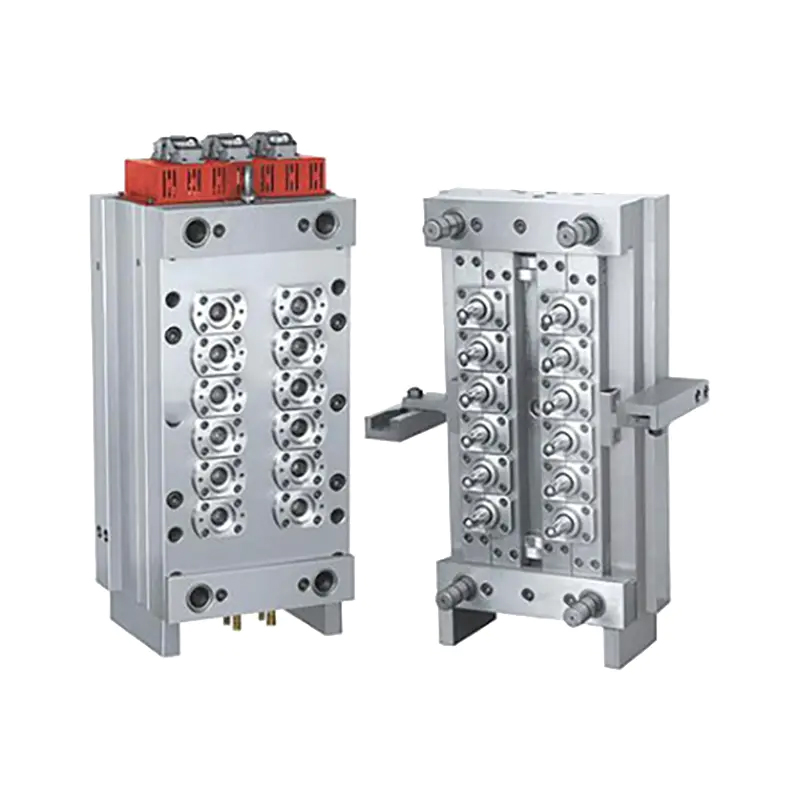At present, the scope of use of preform molds is relatively wide, and it has the characteristics of high quality, energy saving, high efficiency, and long service life, which are favored by more and more manufacturers. So what are the factors that affect the molding of the preform mold? Let's take a closer look.
1. The polymer is transported, melted, kneaded, and pumped out in the extruder to form the formation stage of the parison; in this stage, the factors affecting the distribution of wall thickness are: 1. The molecular weight distribution and average molecular weight of the material; 2. The temperature control system and screw speed of the blow molding machine, during which the temperature control system includes the temperature of the hopper, the temperature of the 1st, 2nd, 3rd and 4th areas of the barrel, the flange temperature and the storage die head 1 and 2. , Zone 3, Zone 4 temperature.
2. The stage in which the parison is extruded from the gap between the die lip and the die core is called the blanking stage. At this moment, the common phenomenon is parison release expansion and parison sagging. The factors that affect these two phenomena are: the die diameter and wall thickness control system of the blow molding machine. The control system includes the axial wall thickness control system and the circumferential wall thickness control system, which is used to adjust the gap between the die lip and the die core. of.
3. In the pre-blowing stage of the parison, in order to avoid the touch and adhesion of the inner surface of the parison, and to improve the uniformity of the wall thickness of the product, the parison should be pre-blown. In the pre-blowing stage of the parison, the air is injected into the parison from below the parison to protect the parison and reduce its vertical extension. At this stage, the factors that affect the distribution of wall thickness are: pre-blowing pressure and pre-blowing time.
4. In the high-pressure blowing stage of the parison, the parison is inflated with high pressure to make it close to the mold cavity to realize the plastic molding of the product. At this stage, the common phenomenon is that the parison is blown and deformed by high pressure, and the parison and the mold cavity are touched and deformed. The factors that affect this situation are: the shrinkage rate of the material; the pressure and time of the blowing; the material and structure of the mold; the mold exhaust system and the mold cooling system, such as the distribution of cooling water channels, the temperature of the cooling water inlet, etc.
Although there are many factors that affect the quality of blow-molded products, when the production conditions and product requirements are determined, adjusting the blow-molding process elements can effectively improve the quality of the products. After all, optimized process elements can improve production efficiency, reduce raw material consumption, and optimize the overall performance of products.
12cavity PET Preform mould
| Product Name | 12cavity PET Preform mould |
| Core &Cavity Steel | S136,FS636,632 (Chinese Steel) ASSAB S136(Sweden) |
| Mould base | P20,4Cr13, Standard Mould Base |
| Steel hardness: | HRC32-35 for slider and stripper palte and other plates |
| HRC49-51 for core and cavity material. | |
| HRC49-51 for Neck ring and Lock ring | |
| Plastic material | PET resin |
| Cavity Number | 1x8, 1x16,1x24,1x32,1x48,1x64,1x72 |
| Injection System | Short tail, Long tail, Pin Valve gate |
| Ejector System | Stripper plate |
| Cycle Time | Based on preform weight |
| Delivery Time | 45-60 Days |
| Mould lifetime | At least 3million Shots |
| Warranty Time | One Year or 1million shots |




 English
English русский
русский Español
Español عربى
عربى






 +86-15157625901 / 13706572756
+86-15157625901 / 13706572756 info@suncomold.com
info@suncomold.com  No.2 Gongxin Avenue, Beicheng Street, Huangyan, Taizhou, Zhejiang, China
No.2 Gongxin Avenue, Beicheng Street, Huangyan, Taizhou, Zhejiang, China